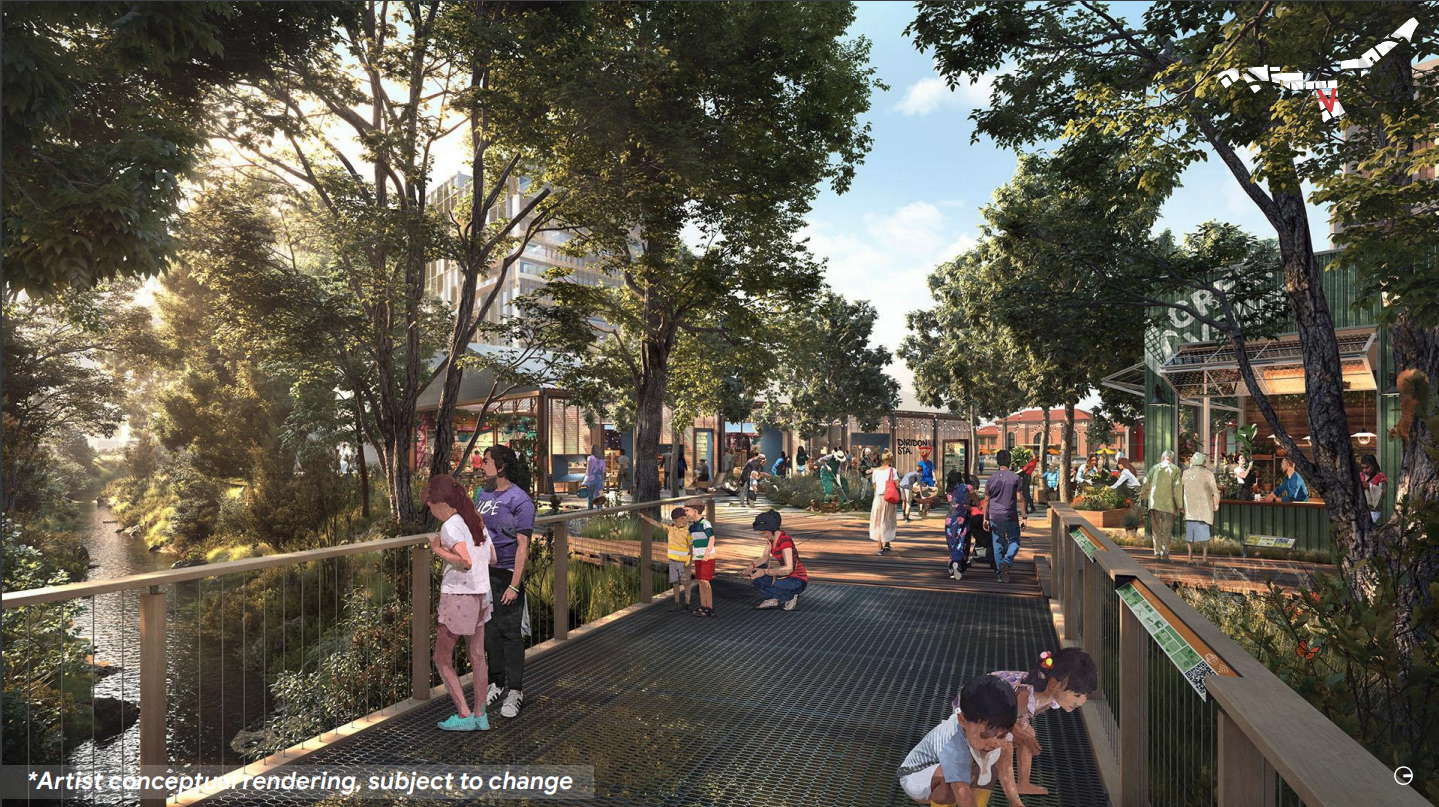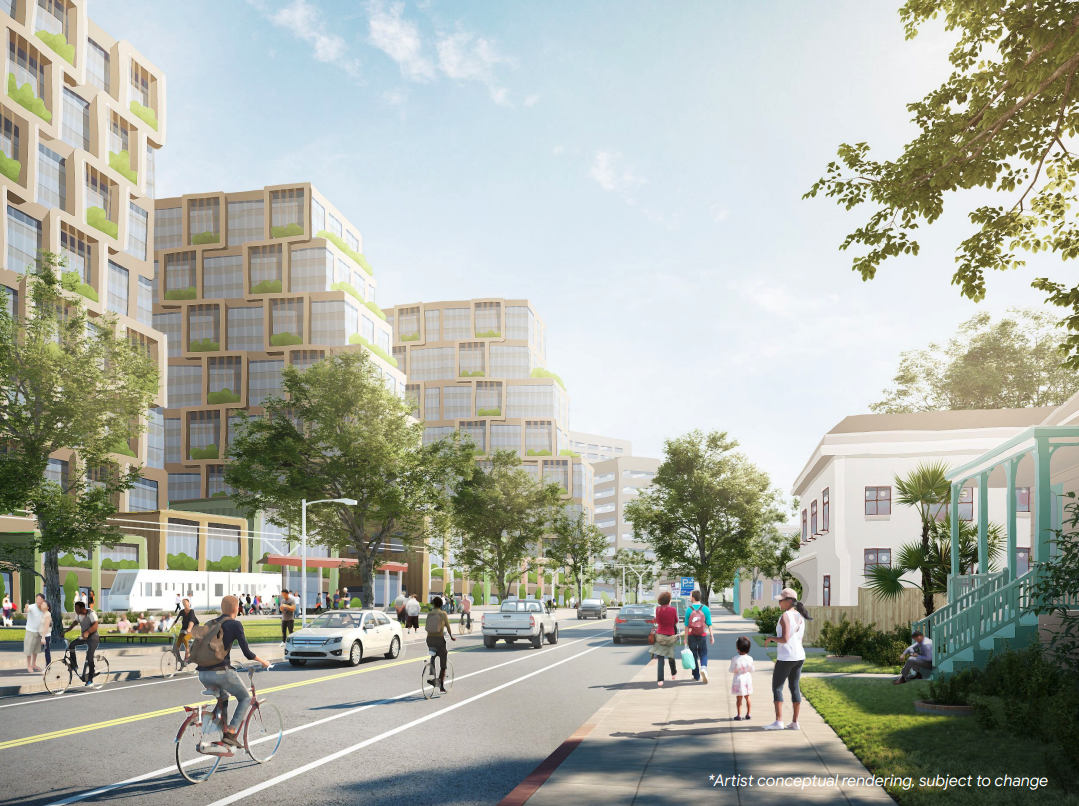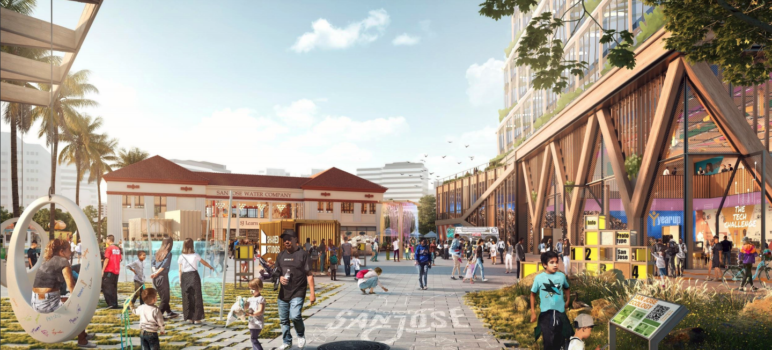Four years ago, San Jose officials gathered excitedly behind a portable podium in a parking lot near the iconic Stephen’s Meats “dancing pig” sign to say Google was mulling a massive campus in the Diridon Station area that would be a boon to the city.
Land sales, closed-door meetings and years of community feedback sessions followed, some interrupted by a persistent group of protesters carrying banners imploring city leaders to say no to Google.
Now, the company has offered a $200 million cherry to sweeten its proposal, known as Downtown West, which also includes hundreds of millions of dollars in infrastructure improvements, developer fees and other gifts. It’s an unprecedented proposal that won over many critics. Still, some say Google’s development agreement does not—and perhaps cannot—go far enough.
“You need economic development to uplift everybody, but it has to be cognizant of the existing conditions of the city,” says Lydon George, a graduate student in San Jose State University’s Urban Planning program. “This agreement, where they’re giving money to local groups … none of it is addressing the systemic issues of widening inequality in the city and in the region.”
The 495-page draft agreement between the City of San Jose and Google follows years of resident feedback to figure out how the company can mitigate the impacts of the proposal. On May 25, city council members are set to decide where the cost-benefit analysis lands with a vote on the project.
Most local leaders, including affordable housing advocates have praised the agreement. “We hope this action serves as a catalyst for housing development in the 240-acre Diridon Station Area, which has the capacity to add up to 15,000 new homes,” Leslye Corsiglia, executive director for SV @ Home said of the proposal.
But some residents remain worried. Jeffrey Buchanan, Working Partnerships’ public policy director, says their fears are understandable.
A 2019 study commissioned by the South Bay Labor Council-sponsored economic think tank Working Partnerships USA estimated the development would result in an average $735-per-month rent increase for existing San Jose residents by 2030. The organization worked extensively with the city and Google to craft an agreement to preserve working class housing. Once a vocal critic of Google in San Jose, Working Partnerships is now a supporter.
“Our work’s not done when it comes to addressing displacement within the development,” Buchanan says. “If we were able to get other developers to take the same kind of approach that Google’s taking, it would make a significant impact in terms of preventing displacement.”
Not all critics are swayed. Jon Gustafson, vice president and general manager of Sharks Sports and Entertainment, says the current proposal would be “devastating” for the Sharks arena at the SAP Center, even with the 2,850 parking spaces Google would preserve for event-goers through construction.
On Sunday, the organization sent a letter to supporters asking them to tell the San Jose Planning Commission—which will discuss the development agreement on April 28—that the team needs a minimum of 4,800 parking spots available on game days. It also urges council members to make more detailed plans to avoid future traffic jams and create new provisions in the document so the city has more control to address, or ask Google to address, future problems that arise during the development.
Short of that, the letter says, the Sharks are unwilling to relinquish to Google their rights to a trio of critical city-owned parking lots, known as the A,B and C lots, in the middle of the proposed development.
“Given our years-long effort to work collaboratively with the city and Google toward a transformative renewal of the Diridon Station area, we are disappointed that we cannot support the Downtown West project as currently planned,” the letter states. “However, the city should not allow this project to proceed at the cost of the arena’s future or the success of the Sharks franchise in San Jose.”

A rendering of Google's Downtown West development. (Courtesy of Google)
Unprecedented Figures
The most comparable offer to Google’s promised gifts in the state came in 2001, when developers pitched roughly $150 million in benefits to build a new entertainment district near Staples Center in Los Angeles.
And the overall benefits from Google’s project far exceed the company’s explicit offer. San Jose estimates the complete benefits—including Google’s plan to build or set aside land for 4,000 homes and infrastructure improvements—total roughly $1.25 billion.
But that grander figure may fall short of what’s needed to stop widespread displacement of low-income residents, some say. Other advocates wondered whether a benefits deal from 2001 offered by real estate developers is comparable to that offered by one of the richest companies in history in 2021.
Google provides the bulk of revenues to Alphabet, its parent company. Alphabet’s operating profit—its revenues minus the cost of goods and day-to-day business expenses—was $41 billion in 2020, or about $112 million per day.
The lawsuit settlements offered by the company in the last few years also rival the value of the project’s estimated benefits. Last year, Alphabet agreed to pay $310 million to resolve a shareholder lawsuit. In 2019, Google agreed to pay $170 million as a settlement for collecting personal information from children.
Sandy Perry, director of the Affordable Housing Network and well-known critic of the proposed Google campus, says there’s a lot to appreciate in the development agreement. That's particularly true in a city like San Jose, where there are more homes than jobs, which puts downward pressure on the city's budget. Even so, the new project may exacerbate inequality, Perry says, as lower income residents fall further behind their already higher income peers.
“City policy has a lot to do with it,” Perry says. “They’re trying to solve their fiscal problems by building the tax base, but there’s got to be a different way of doing that, because all this commercial development without enough housing is displacing their people and making them homeless.”
The Working Partnerships study said the city needs 5,284 affordable homes to offset the impact of the Google development on rents. Google has offered to build or provide land to the city for about 1,000 of those. The rest would be up to future developers who decide to build in the area.
City officials set a goal that 25% of the homes built around Diridon Station would be affordable, but there’s no guarantee how many will rise.
“If we need over 5,000 affordable units to sustainably break even on this development, and we will only get 2,000, that’s inadequate,” Perry says. “It’s not just San Jose, it’s not just Google, but they play a part in it.”

A rendering of Google's Downtown West development along San Fernando. (Courtesy of Google)
Mixed Feelings
Emanuel Jacobo, founder of transportation nonprofit CATLine SJ, says many of his peers are concerned about the growing homeless population and potential displacement.
“I don’t know how, with the information powerhouse that Google is, they don’t know the problems that we’re dealing with,” Jacobo says. “They’re going to be employing 20,000 people that also need a place to stay.”
When asked whether the agreement adequately addresses the impacts on the working class in San Jose, Google reiterated its most widely reported aspects: 4,000 homes in the campus area, most of which would likely be built by Google’s development partner Lendlease; the dedication of four areas of land for affordable homes; and a $154.8 million community fund that would issue grants to local groups.
George says he’s still wary about gentrification. He’s looked at local displacement trends as a part of his graduate studies, and says some of the areas experiencing the most—including the Horseshoe area, the Gardner area and East San Jose—are perilously close to the proposed Google project.
“It’s not [just] Google tearing down a building and putting something else instead,” George says. “It’s putting intense economic pressure on these areas to essentially force people out.”
Advocates like George say it’s critical to not make San Jose’s problems worse. But it’s also not clear how much responsibility Google alone should carry for issues that plagued the region long before the tech giant started buying land for its massive proposed San Jose campus. The Bay Area’s biggest problems are larger than Google, and represent a reckoning with inequality that communities across the U.S. are facing, Perry says.
“These corporations just want to become more wealthy, and they don’t want to take responsibility for the conditions in their communities,” Perry says. “Corporations could end poverty in America before they eat breakfast … and they would barely even notice it.”


San Jose don’t mess this up. Other cities north of you have done far far less to build housing and because of that offer much better quality of life services to their residents. Better parks, better code enforcement better public safety. Not having Google will not solve social issues. A strong budget with more revenue coming in, and the County taking more of a role in social services will do so. That means a little less housing and a little more corporate. Something our neighbors to the north have been practicing for many years.
You gotta love the college student blaming Google for not doing enough to address systemic inequality. Did Google cause it? No, the nature of reality did when it failed to make every human being exactly the same.
All Google has done is make everybody’s life better. But it failed to force everybody to use Google equally, so the company is as guilty as sin.
Thus implieth the graduate student!
I am curious how the graduate student is addressing the inequality that exists between him and other humans.
And once he’s taken action to reduce it, I wonder how he will address the inequality that will still exist between him and other humans.
And once he’s taken action to reduce THAT inequality, I wonder how he will address the inequality that will exist between him and other humans.
As one might guess, this is a never ending gripe that can never be resolved and one that those griping NEVER address themselves. Not that I expect them too. But I can’t help pointing out the hypocrisy and lack of concern with reality.
The one thing you can count on is these liberal socialist wannabes to fuck up every opportunity to strengthen the city’s competitive edge
The only thing you can count on these liberal socialist wannabes to do is mess up one opportunity after another to give the city more competitive edge it badly needs
This really strikes me as ridiculous. These issues have been debated for years. Google has made a great effort to address problems. San José needs jobs and anchor corporations such as Google rarely make this kind of commitment. The city also has lost major development projects in the past by dragging its feet on approvals. This is the kind of massive downtown development the city has sought for three decades. End the discussion.
The “public amenities,” which are never required, will be the first to go, as a rule, if the design changes or the development must be economized — or if politicians or activists make things harder and more expensive.
The question is, would it be more offices and other jobs, which many want, or more housing.
Whatever it is, the city wants to apply activism to the streets, which means there is a threat of loss of capacity, and even without new housing or offices, Google reportedly would be adding 20,000 jobs to the area (whether transferred or new) and many more daily area car trips, from 19,200 to 136,600. Oops. (San Jose wants little more than a third eventually to be by car. Ha, ha, ha.) At least the Sharks are worried (as they should be, since the Insiders don’t care about the team or SAP, probably, either).
https://www.bizjournals.com/sanjose/news/2021/04/26/sap-center-google-san-jose-parking.html
Google will screw you
has NOTHING to do with inequality
A Scorpion wants to cross the river, so he asks a Frog to carry him across the river on its back. The Frog declines, pointing out that the Scorpion is poisonous, and will kill the Frog. The Scorpion counters that the Frog will be in no danger, because if the Scorpion stings the Frog during the watery journey, both will perish.
Buying this logic, the Frog agrees, allowing the Scorpion onto its back, and swims across the river. Only when they reach the middle of the river, the Scorpion stings the Frog. Shocked and dying, the Frog declares “Why? You’ve killed us both!” To which the now drowning Scorpion retorts: “Because I’m a Scorpion.” And they both die.
Except in this case, the scorpion can swim. Michael Phelps level swimmer, and you are less a frog and more like a toad. And like many toads you will end up road kill when Google runs its EV AI driven 18 Wheeler over your face and doesn’t look back. Like it always does.
Chumps
What is the population saturation number?
We are facing shortages of natural resources which negatively impact our quality of life.
Public services have deteriorated as costs have constantly risen.The county collects increased property taxes every year yet we have nothing much to show for it. Every thing is self-service. Do it yourself.
Also, our annual car licensing fees include $20 for the County. Where does that money go as the roads crumble?
The next pandmic is around the corner. High density housing and crowded public transportation exacerbate the “spread”. Look at India now. Again, what is the population saturation number?
To Patrick, nothing like some good old juvenile name calling to spice up an intelligent discussion. Good for you.